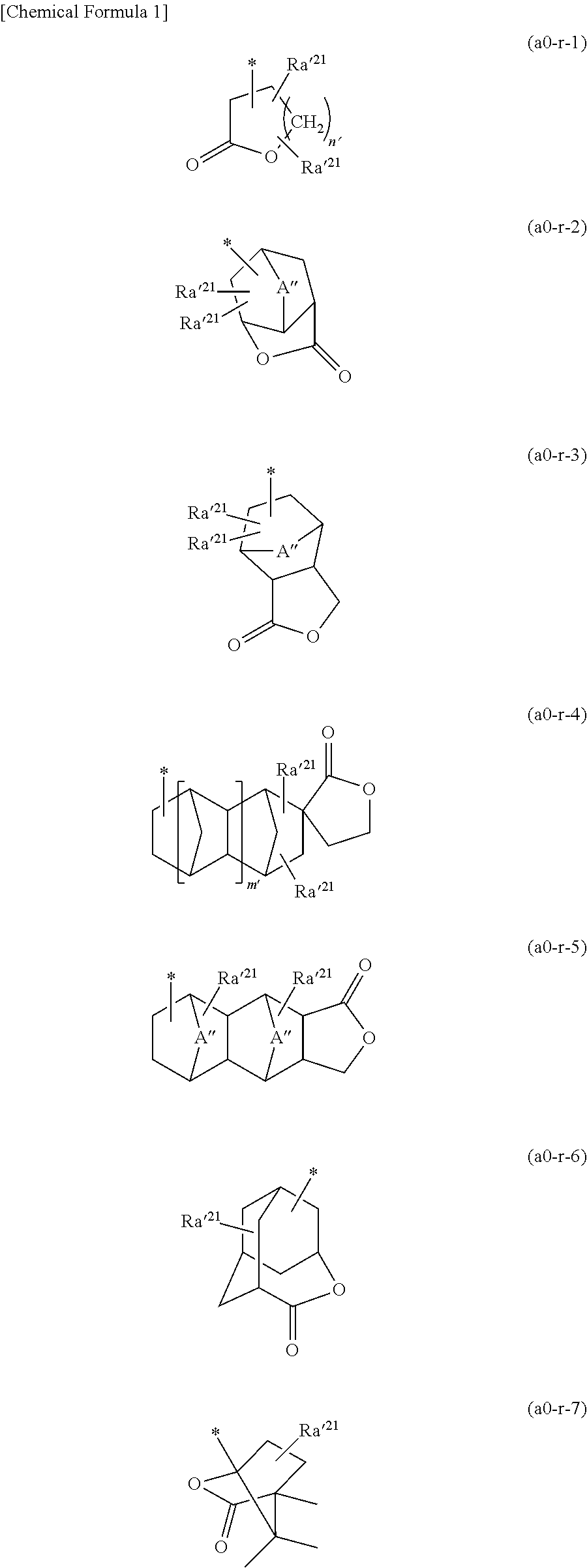Resist composition and method of forming resist pattern
a composition and resist technology, applied in the field of resist composition and resist pattern formation, can solve the problems of difficult to achieve both reduction of roughness and mask reproducibility, and achieve the effect of reducing roughness and excellent mask reproducibility
- Summary
- Abstract
- Description
- Claims
- Application Information
AI Technical Summary
Benefits of technology
Problems solved by technology
Method used
Image
Examples
examples
[0590]As follows is a description of examples of the present invention, although the scope of the present invention is by no way limited by these examples.
[0591]In the following examples, a compound represented by a chemical formula (1) is designated as “compound (1)”, and the same applies for compounds represented by other chemical formulae.
[0592]In the NMR analysis, the internal standard for 1H-NMR and 13C-NMR was tetramethylsilane. The internal standard for 19F-NMR was hexafluorobenzene (provided that the peak of hexafluorobenzene was regarded as −160 ppm).
[0593]
[0594][Synthesis of Compound (Q-1)]
[0595]In a nitrogen atmosphere, 3,5-pyridinedicarboxylic acid (5.0 g), compound (A-1) (12.2 g) and pyridine (150 g) were stirred. Diisopropylcarbodiimide (16.8 g) was dropwise added thereto. Thereafter, the mixture was stirred at room temperature for 24 hours, and pure water (150 g) was then added, thereby stopping the reaction. Thereafter, the resulting mixture was washed three times wi...
examples 1 to 34
, Comparative Examples 1 to 22, Reference Examples 1 to 16
[0608]The components shown in Tables 1 to 4 were mixed together and dissolved to obtain each resist composition.
TABLE 1ComponentComponentComponentComponent(A)Component (B)(D)(F)(S)Example(A)-1(B1)-1———(F)-1(S)-1(S)-21[100][8.0][2.0][10][3200]Example(A)-1(B1)-1(B1)-2——(F)-1(S)-1(S)-22[100][9.0][3.0][2.0][10][3200]Example(A)-1(B1)-1—(B2)-1—(F)-1(S)-1(S)-23[100][3.5][4.2][2.0][10][3200]Example(A)-1(B1)-1——(D)-1(F)-1(S)-1(S)-24[100][9.0][2.8][2.0][10][3200]Example(A)-1(B1)-1(B1)-2(B2)-1—(F)-1(S)-1(S)-25[100][3.5][3.0][5.0][2.0][10][3200]Example(A)-1(B1)-1(B1)-2—(D)-1(F)-1(S)-1(S)-26[100][12.5][3.0][2.8][2.0][10][3200]Example(A)-1(B1)-1—(B2)-1(D)-1(F)-1(S)-1(S)-27[100][6.5][3.3][2.8][2.0][10][3200]Example(A)-1(B1)-1(B1)-2(B2)-1(D)-1(F)-1(S)-1(S)-28[100][3.5][3.0][6.0][2.8][2.0][10][3200]Example(A)-1—(B1)-2(B2)-1—(F)-1(S)-1(S)-29[100][4.5][9.5][2.0][10][3200]Example(A)-1—(B1)-2(B2)-1(D)-1(F)-1(S)-1(S)-210[100][3.0][10.0][2.8][2.0][...
examples 1 to 17
, Comparative Examples 1 to 11, Reference Examples 1 to 8>
[0631]An organic anti-reflection film composition (product name: ARC95, manufactured by Brewer Science Ltd.) was applied to an 12-inch silicon wafer using a spinner, and the composition was then baked at 205° C. for 60 seconds and dried, thereby forming an organic anti-reflection film having a film thickness of 98 nm.
[0632]Then, the resist composition of each example (Examples 1 to 17, Comparative Examples 1 to 11, Reference Examples 1 to 8) was applied to the organic anti-reflection film using a spinner, and was then prebaked (PAB) on a hotplate at 120° C. for 60 seconds and dried, thereby forming a resist film having a film thickness of 80 nm.
[0633]Subsequently, the resist film was selectively irradiated with an ArF excimer laser (193 nm) through a photomask (6% halftone), using an immersion lithography ArF exposure apparatus NSR-S610 (manufactured by Nikon Corporation; NA (numerical aperture)=1.30; Dipole 0.97 / 0.78 w / P; im...
PUM
 Login to View More
Login to View More Abstract
Description
Claims
Application Information
 Login to View More
Login to View More - R&D
- Intellectual Property
- Life Sciences
- Materials
- Tech Scout
- Unparalleled Data Quality
- Higher Quality Content
- 60% Fewer Hallucinations
Browse by: Latest US Patents, China's latest patents, Technical Efficacy Thesaurus, Application Domain, Technology Topic, Popular Technical Reports.
© 2025 PatSnap. All rights reserved.Legal|Privacy policy|Modern Slavery Act Transparency Statement|Sitemap|About US| Contact US: help@patsnap.com



